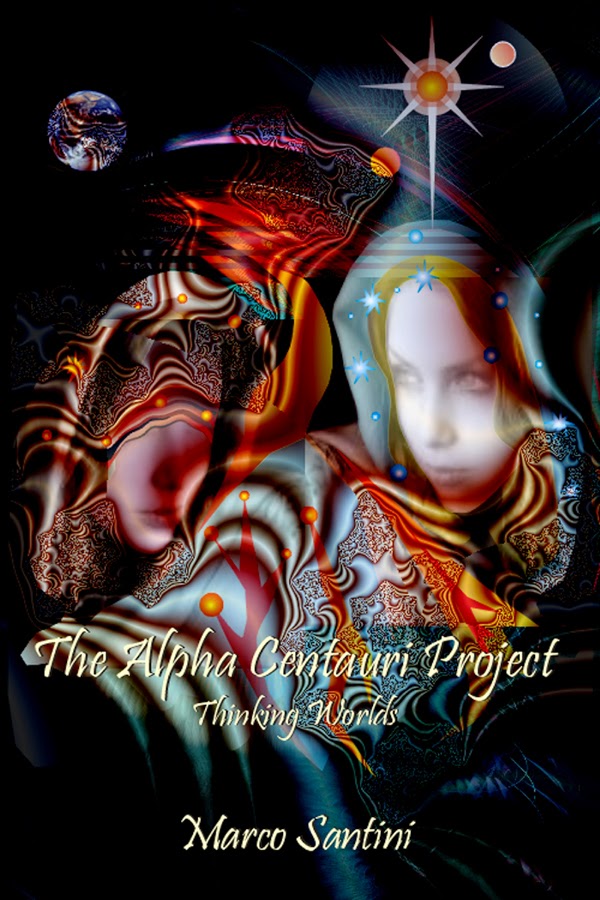And here is
the last post dedicated to the representation of post-physical life in
science fiction. In the first post I introduced the topic and gave a few
examples of the so-called soft and intermediate approaches (click here to read the post), in the second post I focused on the hard approach and in particular
on cyberpunk (read post here), in this third post, instead, I present two books
in which, in different ways, there is also the return of the digitized
consciousness seen in the hard approach towards a physical life.
The
examples that I’m offering aren’t famous novels, but two books by
self-publishers.
The
Alpha Centauri Project (Thinking Worlds) by Marco Santini is a novel available as e-book
(free). It describes a future where there is a conflict between a type of humanity
in the flesh and another one which lives in the net, i.e. derived from the
digitization of the consciousness of the dead. The two humanities are able to
interact with each other both through the virtual reality and the physical
world. The digitized, in fact, may temporarily download into androids and
experience once again a physical life. This gives to the latter a greater
freedom, except for the fact that they depend on the existence of a physical unit
that makes the net work.
The future
imagined by Santini is very intriguing and sometimes disturbing. In this
regard, I invite you to read my review of the book.
Amantarra
(book 1 of the
trilogy entitled The Ascension of Valheel) by Richard J. Galloway is a novel that deals with the
subject of the digitization of consciousness from a completely different point
of view: that of an alien race.
The Bruwnan
existed for half the age of the universe and, after reaching the maximum
possible evolution in the physical form, decide to leave their bodies back
and go to a post-physical life. Their digitized consciousness lives for
billions of years in a virtual city, Valheel, built inside a sphere. The
process of digital copying causes the simultaneous death of the body. But
Valheel is not in our space-time, it exists in a sort of alternate reality
and in order to remain active it draws energy from biomass which is
located in the planets where the Bruwnan have instilled life.
Some of them,
Amantarra and her father Artullus, realise that for millions of years the
population of Valheel is decreasing, which shouldn’t happen because the
digitized consciousness does not die. Something that dwells in the virtual
reality is deleting them. The search for a solution takes Amantarra to Earth
at the time of primitive men, through the centuries, until the 70s of the
twentieth century, where she interacts with some boys at a high school in England
You can
read my review of this book as well.
"Amantarra"
is available in e-book for just 99 cents on Amazon and other retailers.
In general,
post-physical life always involves a transition from living/organic matter
to something that is non-material
(the ascended spirit, the ghost of the Jedi, and so on) or that dwells in
inorganic matter (server). Even if the digitized consciousness is a
software and therefore immaterial, however, it is always something measurable
and requires external energy to survive.
Speaking,
however, about metaphors of the immortality of the soul, in the context
of science fiction there is room for its representation without the passage
above. This is observed in all those stories where consciousness moves,
by means of more or less scientific methods, from living matter to other
living matter, which may also be different, by means of an
organic/biological process or with a digital intermediary but in which that
consciousness is not active (it is only a means of transmission). In this
context, you can note similarities to the spiritual/religious concept of reincarnation,
but it would deserve a separate analysis.
Finally, it
can be frequently seen in the stories narrating the transition from living
matter to other living matter that this is shown without providing an
explanation, as in a lot of science fiction concerning cloning. Each
clone, like magic, seems to have all or part of the background of the original,
although cloning is to all intents and purposes a copy of the body from its
genome but not of the consciousness that lived in it (or memories that
defined the consciousness as such) and therefore has nothing to do with the
subject of the immortality of the soul. Sometimes, when they want the
individual to believe to be the original, the presence of such knowledge is
desired (I don’t offer examples to avoid spoilers). In other cases, however, it
is even an error in the process of cloning causing troubles for those who
wanted to make use of these clones for their own purposes. Oops!


No comments:
Post a Comment